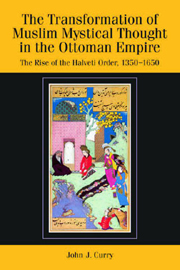 The Transformation of Muslim Mystical Thought in the Ottoman Empire
The Transformation of Muslim Mystical Thought in the Ottoman Empire from PART II - THE EVOLUTION OF A HALVETİ SUB-BRANCH: THE LIFE AND CAREER OF ŞAcBÂN-I VELİ AND HIS FOLLOWERS IN THE KASTAMONU REGION
Published online by Cambridge University Press: 12 September 2012
While some Muslim saints were born into prominent family lineages and attracted historical attention from their earliest years, Şacbân-ı Veli was not among this group and only rose to prominence in a later era. Therefore, the picture we receive of his early life and his eventual incorporation into the following of the Halveti order is among the most ill-documented parts of his life. Nevertheless, these events are not without value for the historian if they are placed within the political, religious, and social context of early tenth/sixteenth-century Asia Minor under a recently ascendant Ottoman state.
ANTECEDENTS OF ISLAMIC AND SUFI CULTURE IN KASTAMONU BEFORE THE ARRIVAL OF ŞAcBÂN-I VELİ
By the time Şacbân-ı Veli made his home in Kastamonu in the first half of the tenth/sixteenth century, the city had already been integrated into the Islamic world for several centuries. After the invasions of the Seljuks, various Turcoman tribes, and Latin Crusaders following the defeat of the Byzantines by the Seljuk ruler Alp Arslan at Manzikert in 463/1071, a Turcoman dynasty known as the Danishmendids established themselves in north-central Anatolia. They appear to have first taken control of Kastamonu in 498/1105. Although the city passed briefly back into Byzantine hands periodically over the subsequent three decades in conjunction with campaigns of various Byzantine rulers and generals into the Anatolian plateau, a nominally Muslim sovereign ruled over the city until the Ottoman absorption of the province following the conquest of Constantinople in 857/1453.
To save this book to your Kindle, first ensure [email protected] is added to your Approved Personal Document E-mail List under your Personal Document Settings on the Manage Your Content and Devices page of your Amazon account. Then enter the ‘name’ part of your Kindle email address below. Find out more about saving to your Kindle.
Note you can select to save to either the @free.kindle.com or @kindle.com variations. ‘@free.kindle.com’ emails are free but can only be saved to your device when it is connected to wi-fi. ‘@kindle.com’ emails can be delivered even when you are not connected to wi-fi, but note that service fees apply.
Find out more about the Kindle Personal Document Service.
To save content items to your account, please confirm that you agree to abide by our usage policies. If this is the first time you use this feature, you will be asked to authorise Cambridge Core to connect with your account. Find out more about saving content to Dropbox.
To save content items to your account, please confirm that you agree to abide by our usage policies. If this is the first time you use this feature, you will be asked to authorise Cambridge Core to connect with your account. Find out more about saving content to Google Drive.